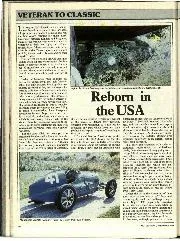
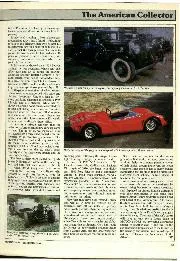
Veteran to classic: The American collector
Reborn in the USA It is easy to feel pleased, or even smug, about the old car scene in Britain: we have a huge number of ancient vehicles and run…
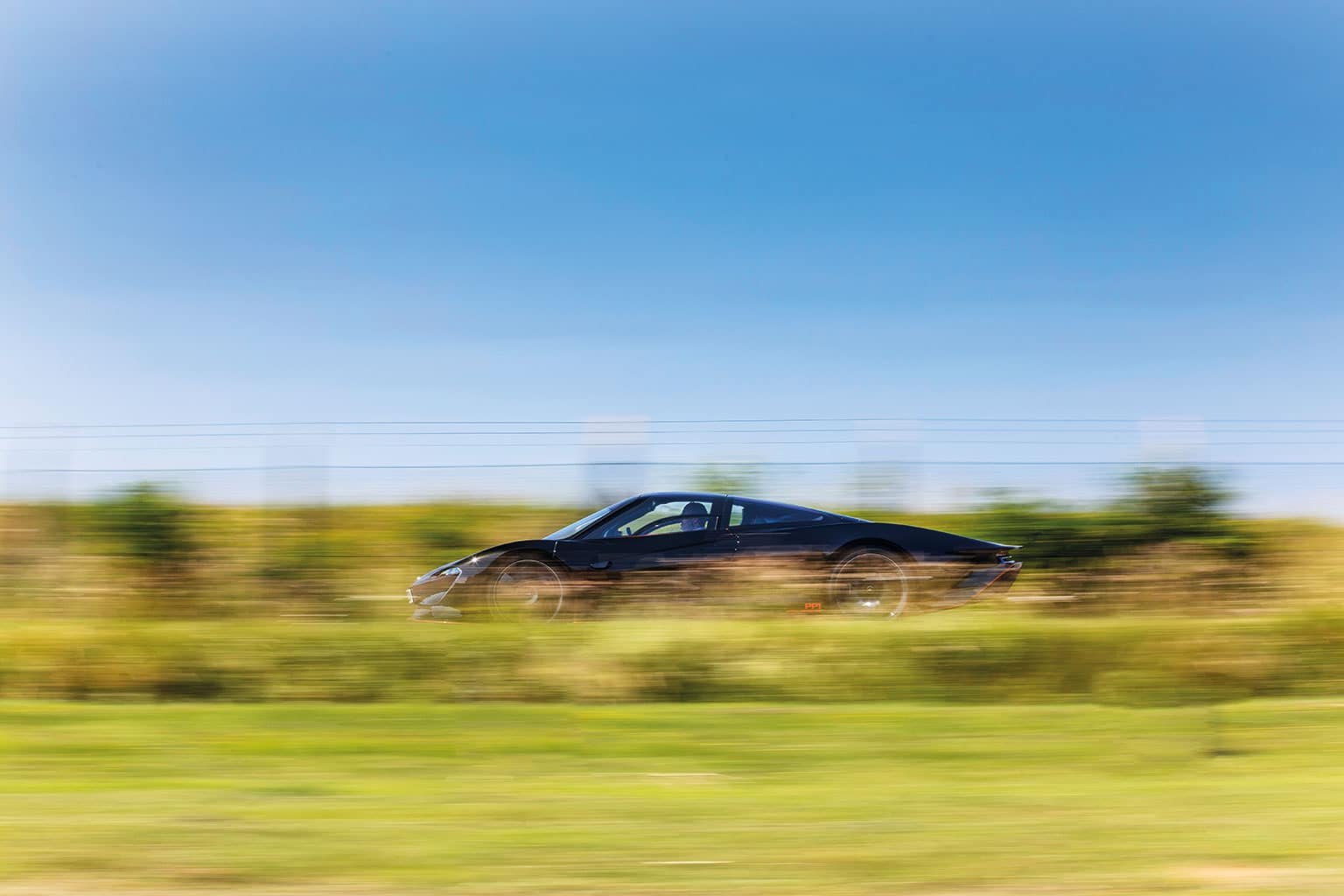
At a colossal £1.85m more than McLaren’s 720S supercar, can the Speedtail hyper-GT live up to its billing?
There are lots of things McLaren would like you to think about when contemplating its extraordinary new Speedtail hypercar, most obviously the McLaren F1, whose three-seat, arrow-head cabin configuration it shares, along with a production run of just 106 units. How it’s quicker from rest to 186mph (300kph) than a Bugatti Chiron is another. But what Woking’s grands fromages will neither want nor expect you to be thinking about are 50-something-year-old Porsches. But I can’t help myself.
Because when I look at the Speedtail, I see not only a stunningly modern and striking road car shape, but one that was in vogue in an entirely different context half a century ago. Cab forward, tail back, here I see a 1968 Porsche 908 using its elongated bodywork to punch through 200mph on Le Mans’ Mulsanne Straight.
Clearly this is not intentional, but nor is it coincidence. McLaren’s designers today were faced with the same challenge as were Porsche’s back then: How to extract maximum straight-line speed on a limited amount of power. Of course, all things are relative and few indeed would feel short-changed by the combined 1055bhp created by the McLaren’s 4-litre twin-turbo V8 petrol engine and the electric motor that sits between it and its seven-speed gearbox; but compared to the 1479bhp produced by the aforementioned Bugatti with double the capacity and cylinder count, you can see the same problem the 3-litre 908 faced when pitched against the 5-litre Ford GT40.
The answer then as now is to build a car that is light (would you believe nearly half a tonne lighter than the Chiron?) to help it gain velocity, and as it is not mass but drag that has the most deleterious effect on top speed, make it as slippery as humanly possible, hence the fared-in wheels, teardrop shape and bodywork the Germans would call ‘langheck’, the Italians the rather more romantic ‘coda lunga’, and us simply ‘long tail’.
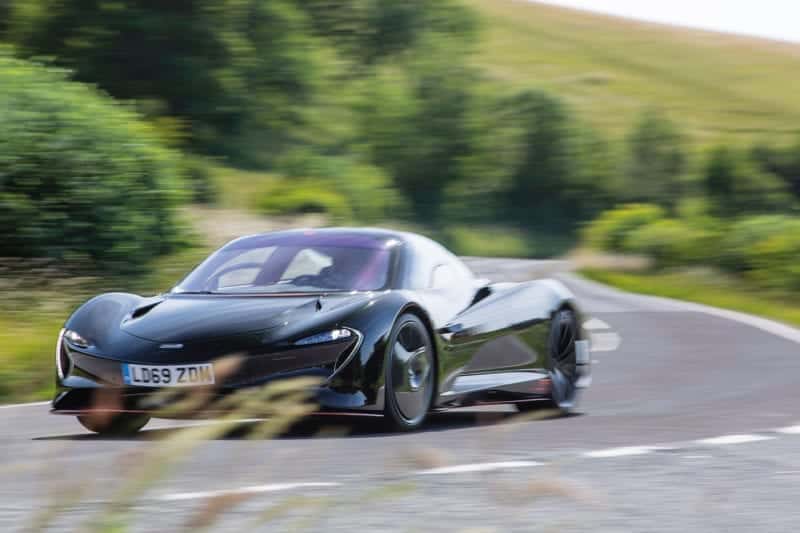
The central-seat driving position harks back to the legendary McLaren F1, and feels a lot more natural than you’d imagine
And long it is: at 5143mm in length, the Speedtail is over half a metre longer than a 720S, longer even than a standard wheelbase Mercedes S-class. It even has two rear ailerons that flip up with speed to stabilise the car. No, they’re not suspension actuated like those on the 908LH, nor are they mounted on a separate wing but, extraordinarily, as part of the actual carbon fibre bodywork, but the idea is the same. Long tail indeed, except inconveniently, McLaren uses the LT acronym for other cars, so the rather more awkward ‘Speedtail’ it is.
But you can call it what you like so long as you don’t call it the replacement for the McLaren F1. Yes, McLaren is keen to make the association, but points out very quickly that while the F1 was as famous for its exploits on track as on road, the Speedtail is very much a street machine, a ‘hyper-GT’, whatever that is. You may counter that the F1 was never designed as a racing car either and developing it for the track was very much an afterthought; you may even look at the Speedtail’s oh-so slippery shape and the quadruple-digit power out of its powertrain and wonder if therein did not lie a pretty sound basis from which to develop a car for the new hybrid hypercar race regs, but as those remain a fairly mobile set of goalposts, I’ll just leave the thought with you and proceed to more immediate matters.
I’m going to dwell on the £2.1 million price, or whether it is therefore worth £1.85 million more than a 720S. Such questions miss the point. The only determinant of value for a limited-volume car is whether it sells out or not. And the Speedtail has, with some customers loading their cars with so much bespoke tailoring, jewellery and precious metals that gossip in the trade of transaction prices beyond £3 million seem entirely believable. The electrically-powered dihedral doors open remotely, rising gracefully to reveal an interior like no other. Your first fear, that it will be as inelegant to enter and exit as an F1, is groundless. So long as the driver’s seat is relatively rearward on its runners (the others don’t move), even large middle-aged blokes like me can just slide across. You are presented with a panorama of the road ahead and three screens: driving data in front of you, navigation to your left, entertainment to your right. Such buttons as there are exist out of sight in the headlining, or for those you use least, down by your knees. There is not a single switch on the steering wheel, nor is any needed. It is a stunning environment.
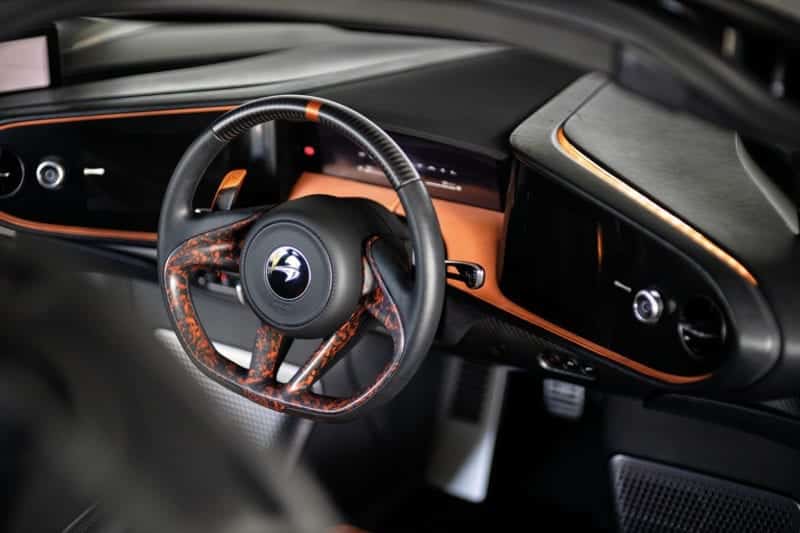
The cabin is gloriously uncluttered, with a trio of screens delivering the driver all of the essential information
Yet to operate, it is like any other McLaren. Unlike its last hybrid, the P1, the Speedtail can’t run on electricity alone and the engine sound is the familiar hard-edged but not particularly tuneful growl of a flat plane V8. A V12, like that in the F1, would clearly be preferable.
Tug a paddle, press a pedal and you’re off, marvelling at once at how natural the central driving position feels. Thereafter the only time you realise you are always mentally compensating for being at a different angle to an apex depending on whether it is to the left or right is when you no longer have to.
I am alone in here, which is how I’d prefer it even were it not forced upon me by COVID. Perhaps the biggest disappointment of the Speedtail is that the three-seat driving position only works if large drivers have small passengers or large passengers have a small driver. Simply put, with the driver’s seat all the way back, there is insufficient space for the passengers’ inboard shoulder. But I guess Speedtail owners will have several, if not dozens of other cars from which to choose for family occasions, if indeed their Speedtail is used at all. Or significant others will just be flown ahead on the jet…
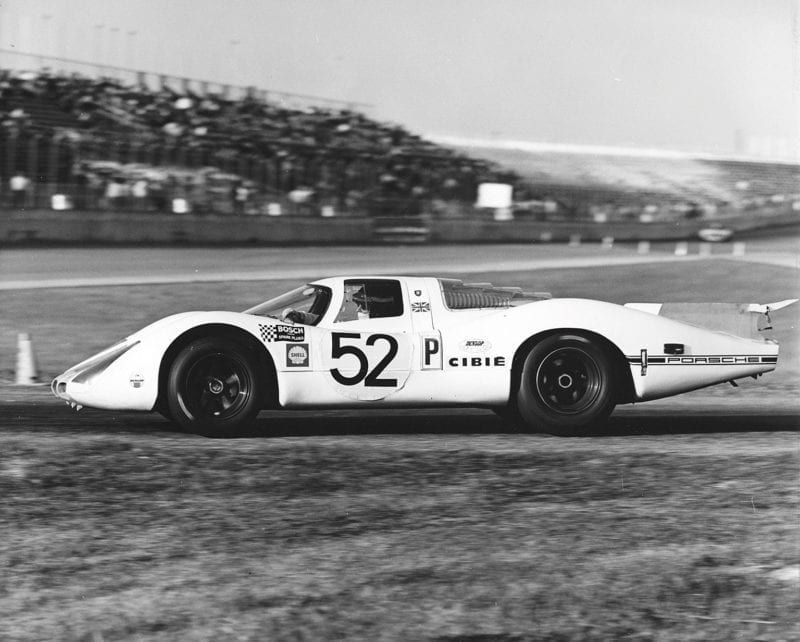
Modern design based on classic thinking. Porsche pioneered the ‘langheck’ on the 908 in 1968
Getty
It is amazing how quickly you feel at home in here. I remember the P1 feeling quite daunting with its myriad modes, DRS and wild looks. The Speedtail does have a Sport mode (and you’ll need to be in it before it will release maximum torque) and even a ‘velocity’ mode for those who really feel the need to see if it will do 250mph, but their buttons are up out of sight in the roof. As for that top speed, it’s actually capable of far more, but McLaren limits it to 250mph so it doesn’t require the heavier wheels, tyres, suspension and brakes that would be required to facilitate safely the pointless pursuit of going any faster.
And you wouldn’t want to spoil a car that handles and rides like this. Because it sits on a longer wheelbase than any other McLaren and thanks to being fitted with the lowest-geared rack at McLaren’s disposal, the Speedtail’s steering is accurate, linear and perfectly weighted, as you might expect, but slower too, so there is no aggression whatever off centre, which is just how I like it. The ride is exceptional too, the best of any hypercar I’ve driven and better by far than that of any number of allegedly comfort-oriented saloons.
The roads open up. I’m lucky that in a still partially locked-down country, there is space enough to put this car through its paces, albeit not fully. I at least managed get a feel for its capabilities, a taste of its potential.
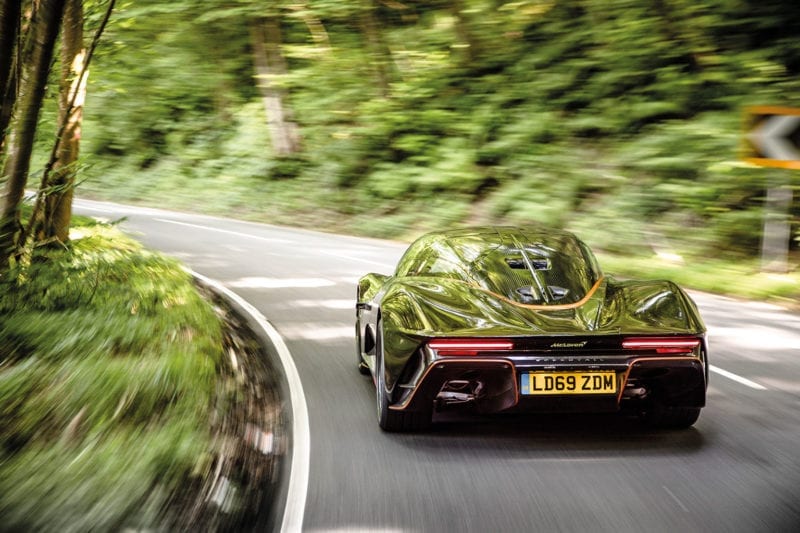
Despite being as long as a Mercedes saloon, the Speedtail is still half a tonne lighter than a Bugatti Chiron
It is fast in a way no other road car I have driven is fast. The numbers say it’s slower to both 100 and 200kph than a Chiron, but that’s because those numbers are still influenced by traction, of which the all-wheel-drive Bugatti has twice as much. But by 300kph, the aerodynamic efficiency of the Speedtail starts to tell, so not even Molsheim’s finest can live with it.
Most of the time it just makes you laugh as you’re speared across the scenery, but that’s because most of the time the Speedtail can’t actually put all its power down. Unbeknown to you, your progress is being silently, seamlessly limited by the electronics.
Find a road smooth enough and put your foot to the floor at a speed high enough for all 848lb ft of torque to find its way to the street, and the effect is as if someone has grabbed both sides of the horizon and ripped it towards your eyes. It is incredible, astonishing, almost unbelievable. But so too it is violent, disorienting and disconcerting.
You have to experience it once because it is like no other in the road car theatre, but how many owners will regularly avail themselves of this facility? Approximately none, I would estimate. It is a party trick like no other, but in no way does it feature in the routine experience of this car. It does it because it can, and owners like to know that it will, even if they never do. Which is fair enough.
Truth is I’m far more interested in what it is like to drive when you’re not risking merely your licence but your very liberty. And this is where I fear some may miss the point of the Speedtail. Because of the name it’s been given, the four digits in its power output and that rather eye-catching top speed, there’s a temptation to think of it purely as a straight-line machine. It is anything but.
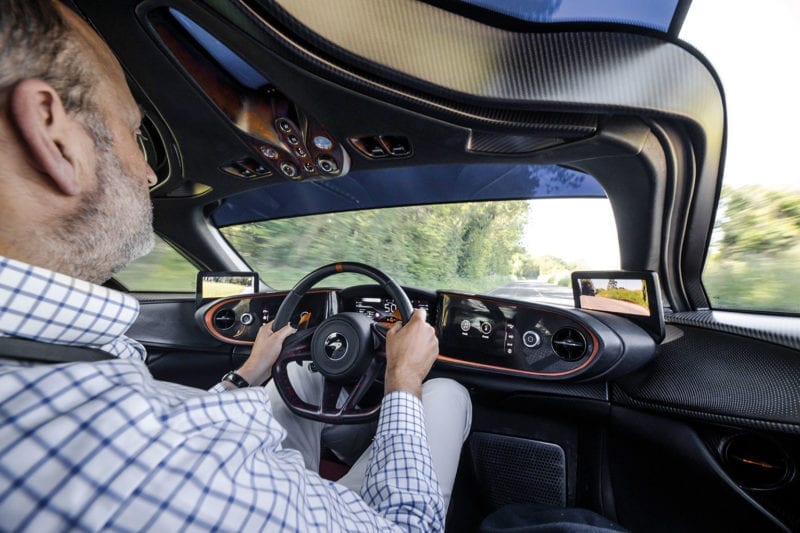
The Speedtail cockpit provides a stunning driving environment. Note the wing mirrors being replaced by twin screens flanking the dash
Indeed and within the admittedly somewhat limited confines of the public road, I found myself enjoying it far more on roads that swung and swerved their way from place to place. With the possible exception of last year’s GT, this is perhaps the first McLaren to be developed without a thought for track performance and out here on long, fast and open A and B roads, it is all the better for it.
For a start because it is quite softly sprung it has excellent traction despite all that torque and what remains a cleverly controlled but nevertheless open differential. Not only is it not deflected by every day lumps and bumps, it barely notices them. And the steering, thanks to McLaren’s dogged determination not to forsake hydraulic assistance in favour of a more efficient but less tactile electric rack, is quite superb. Another reason for this is that despite all its power, McLaren has not fitted the widest possible tyres to the Speedtail, nor anything close. The rubber has been specially developed with Pirelli, but the front tyres’ 235/35 width and profile are no greater than you’ll find on a Ford Focus ST.
What this means is that the Speedtail is far more multi-dimensional than its most obvious traits suggest. Because it derives its pace as much from lightness and aerodynamic efficiency as it does from pure brute force it is a car that actually interacts with the driver, involving him or her in the process. I’ve not driven a Chiron, but I have driven a couple of Veyrons, including the 1200bhp Veyron Super Sport and these are cars that put on a performance for you to watch. And very impressive it is, too. But other than in the most literal of senses, you’re not that involved. The Speedtail involves you in the tactility of its steering and the unambiguous messages fed back to your body through the chassis. It is a car for real drivers, an exquisite thing to handle.
Were the Speedtail just a beautiful car with an incredible interior and mind boggling set of statistics to go with it, I expect that would have been more than enough to ensure its success. Indeed all were sold before any of its owners got to drive one. And I know all but a handful will be closeted away and rarely, if ever, see a good open road spool out before them. But for those few owners who do decide to use their Speedtail for the purpose for which it was designed will be well rewarded, for a rare and special experience awaits. For McLaren’s flagship model, nothing less should be expected.
